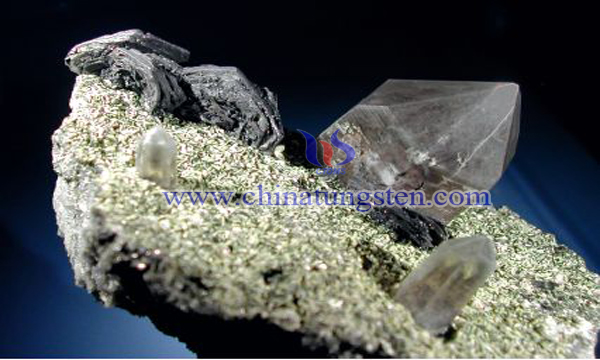A Method to Separate Tungsten and Tin from High-Tin Tungsten Concentrate
- Details
- Category: Tungsten Information
- Published on Wednesday, 01 August 2018 17:25
Tungsten is mainly enriched in the granite contact metamorphic zone in the crust, and is more or less symbiotic with tin containing minerals in many tungsten deposits, especially porphyry-type tungsten deposits - such tungsten-containing polymetallic vulcanization ore is often associated with tin-containing minerals.

In the froth flotation process, the tungsten-tin symbiotic ore has poor separation effect, and the comprehensive utilization is difficult. The amount of tin metal discharged to the tailings pond is 1,500 tons per year. In the increasingly endowment of tungsten resources, how to comprehensively recover tin and tungsten in high-tin tungsten concentrate has been widely concerned by many researchers in recent years.
In the existing concentration process to separate tungsten-tin polymetallic ore, tin eventually enters the tailings of the scheelite flotation. The valuable metals in the tailings are mainly wolframite, cassiterite and a small amount of scheelite. Since wolframite and cassiterite are interfered by a large amount of chemicals, their floatability is very poor, and it is difficult to achieve effective recovery of tungsten and tin by froth flotation. And the tungsten ore in the tailings has a very fine particle size, and it is difficult to achieve a good recycling effect by using a conventional gravity concentration shaker.
Therefore, it is necessary to replace the method of treating tin-tungsten with high-tin tungsten concentrate by a completely different idea from the above-mentioned technique. For example, the tin in the mineral is recovered first, and the high-efficiency separation of the tungsten and tin is achieved to avoid the tin seriously affecting the metallurgy of the tungsten, and then recovering the tungsten.
The process is as follows:
The high tin tungsten concentrate (containing 35.7% of WO3, 4.2% of Sn, and 0.68% of K) 100g, the molar ratio of the amount of gypsum to the total content of tungsten, tin and potassium in the mineral is 1.5:1. The ratio of wind to coal is controlled at 0.7, the blowing temperature is controlled at 1250 °C for 2 h, and the volatilization rate of tin is 98.6%. The high temperature dust-containing flue gas is recovered by the waste heat boiler, and then passed through the sedimentation chamber to collect electricity. The way to get tin concentrate contains 45.2% Sn. The tungsten-containing slag crushing ball mill has a particle size of 98% or more over 325 mesh sieve, and then leaching. The water leaching ratio is 1:1, the water immersion temperature is 50 ° C, the leaching time is 2 h, and the K leaching rate is 82.1%. After the leaching, the filtrate is decomposed by sulfuric acid and phosphoric acid. The liquid-solid ratio of sulfur and phosphorus mixed acid leaching is 4:1, the temperature is 80 ° C, the time is 4 h, the sulfuric acid concentration is 250 g / L, the phosphoric acid concentration is 150 g / L, and the leaching rate of tungsten It is 99.7%.
The principle of this method is: firstly add the mixed high-tin tungsten concentrate and vulcanizing agent gypsum to the flue gasifier, and control the furnace temperature and atmosphere by adjusting the wind-coal ratio of the furnace. The tin is blew in as SnS gas, and the dust-containing flue gas enters the settling chamber, and the high-grade tin concentrate is obtained by electric dust collection, and the tungsten enters the slag, and the slag is used for recovering tungsten.
This method uses calcium sulfate as a vulcanizing agent for tin to achieve high-efficiency separation of tungsten and tin. Simultaneously, the transformation of black tungsten and the decomposition of accompanying K-feldspar minerals are realized, and then the tungsten-containing slag is washed with potassium to reduce tungsten smelting. In addition to the pressure of potassium in the system transformation, the technology of sulphur-phosphorus mixed acid treatment of scheelite is closely linked, which is a multi-pronged solution.
- Tungsten Manufacturer & Supplier, Chinatungsten Online: www.chinatungsten.com
- Tungsten News & Prices of China Tungsten Industry Association: www.ctia.com.cn
- Molybdenum News & Price: news.molybdenum.com.cn
- Tel.: 86 592 5129696; Fax: 86 592 5129797; Email: sales@chinatungsten.com



 sales@chinatungsten.com
sales@chinatungsten.com